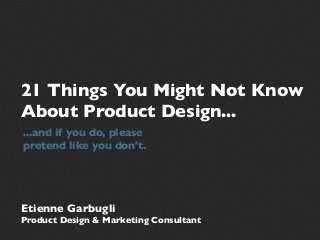
21 Things You Might Not Know About Product Design...
- 1. 21 Things You Might Not Know About Product Design... ...and if you do, please pretend like you don't. Etienne Garbugli Product Design & Marketing Consultant
- 2. Me me me.
- 3. •Comms / Marketing background •First (Geocities) Website in 1998 •Founded 2 startups (Flagback & HireVoice) •Senior Usability / UX Expert •Author of Lean B2B: Build Products Businesses Want
- 4. 1. Ideas are nothing without proper execution
- 5. } Boo.com
- 6. 2. Most people only really use 5 to 7 services
- 7. }
- 8. 3. You can’t easily change user behavior
- 11. Company name is for market segment who are dissatisfied with problem being solved. Our product name or service offering provides companies with benefits. Unlike our competitors, we have proprietary advantage. }
- 12. 5. Challenge the Status Quo
- 13. }
- 14. 6. You may not need a signup
- 15. Tripit.com
- 16. 7. Perceived value is key
- 17. } Moof.com
- 18. 8. You don’t have to build everything
- 19. }
- 20. 9. Others have done it before
- 21. }
- 22. 10. The longer it takes to develop, the less likely it is to launch
- 23. } L
- 24. 11. Typing is a barrier to entry
- 25. }
- 27. }
- 29. }
- 30. }
- 31. 14. The blank state should not be blank
- 32. } Dokdok.net
- 34. }
- 35. 16. (Great) UX can create word of mouth
- 36. Mint.com }
- 37. 17. Copying can be dangerous
- 39. 18. Good design feels natural
- 41. 19. You need metrics to survive
- 42. }
- 43. 20. Features are best introduced one at a time
- 44. } Batch Import and Export of catalogue Product comparisons Product Reviews Layered / Faceted Navigation for filtering of products in Search Results Shopping Cart Report Product Image Zoom-in Downloadable Products Capability Abandoned Shipping to multiple addresses in one order Order Tracking from Account A/B and Multivariate Testing Google Base Integration Meta-information for products and categories Admin Dashboard for Report Overview
- 45. 21. You can’t know everything
- 46. } POST analysis Heuristic evaluations Lean startup methodology 5 second test Scrum A/B testing SWOT analysis Aarrr metrics 4Q surveys Cost-benefit analysis Conversion funnel Analysis Price Point Analysis Personas
- 47. +1 Bonus
- 48. “Progress is not the number of features, it's user behavior change.” - Dave McClure, Entrepreneur & Investor }
- 49. Thank you. Etienne Garbugli Product Design & Marketing Consultant Email: Etienne@leanb2bbook.com Blog: www.leanb2bbook.com Twitter: @egarbugli
Editor's Notes
- The idea: Sell expensive branded fashion apparel. Spent: $135 million in 6 months. Highlights: When Boo.com went bust, they owed over $21million to creditors. Boo.com's software and technology purchased at $70 million, were sold off for $250k. What went wrong? They built a site using JavaScript and Flash in the days of 56k modems so users had to wait ages to load the site, they also employed 400 people when they only needed 30. Source: 37 Signals, Getting Real
- Most people really only heavily use about 5 to 7 services. If you want to be an important product and a big business, you will need to figure out how to fit into one of those 5 to 7 services, which means capturing your user’s fascination, enthusiasm, and trust. You need to give your users a real reason to add you into their time. (Jason Goldberg)
- Don't think you can change behaviors in social media, use them the way people already use them (sylvain amoros)
- Understand your meaning, what you’re enabling (benefits). How do you know? Really?
- Understand why the things are designed a certain way, adapt if needed. Every page needs a purpose (Seth Godin). Learn to deconstruct to understand how things are made and recognize patterns. (Ex. music with tablatures.)
- Goal time (time spent achieving your objective perceived as High value) and Tool time (time spent using the tools perceived as Low value). Reduce Tool time. Think you’re clever, you’re merely annoying…
- Forget about 'have tos' early on, plenty of time later on. Figure out what the lowest level of approximation possible is and start with it (eg. Flagback positioning).
- Don't build things/features that can be easily done using Open Source (eg. Paypal). Only build what is core to your product. Use open source for everything else (eg. Paypal). Open source ideas
- The longer it takes to develop, the less likely it is to launch (37 signals).
- Typing is more of a barrier to entry than clicking
- Content actually matters
- think visual flow What do you notice?
- think visual flow What do you notice?
- The Blank State Should Not Be Blank
- Always look for ways to provide an overview .
- Try to include Wow moments in your product to get people talking about the UX (Mint, Aaron Forth).
- copying design can be dangerous Jared Spool
- Right options at the right time and position. Eliminate unneeded Elements (especially true for conversion funnels). Design is reductive process. A/B test Make it feel natural.
- Track every step of the funnel (landing, sign up, usage, etc) to see where there’s problems (Web design for ROI).
- Introduce 1 feature at a time to be able to evaluate and roll back if necessary (Web design for ROI).
- Do you know what POST analysis, heuristic, etc are? No, well you don't know everything keep that in mind.
